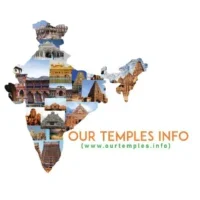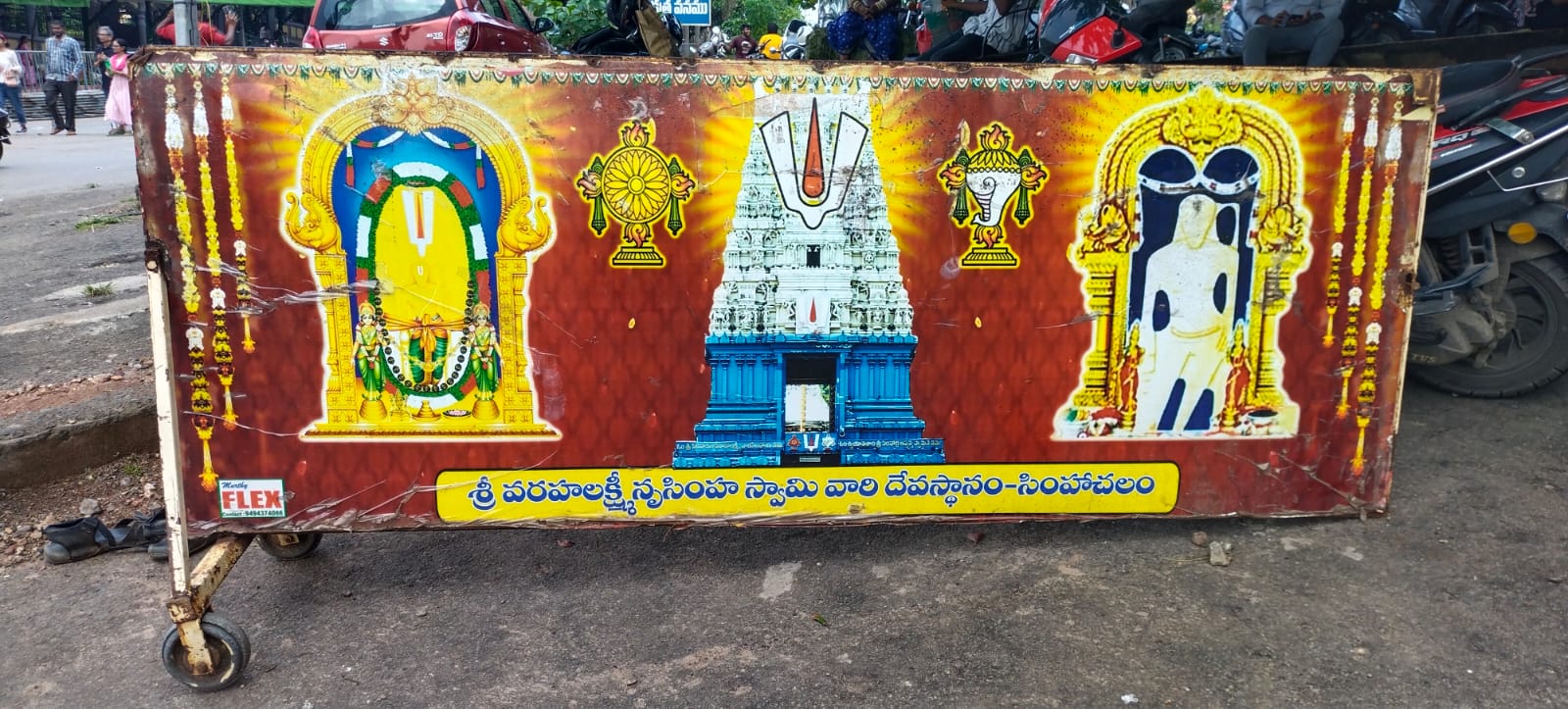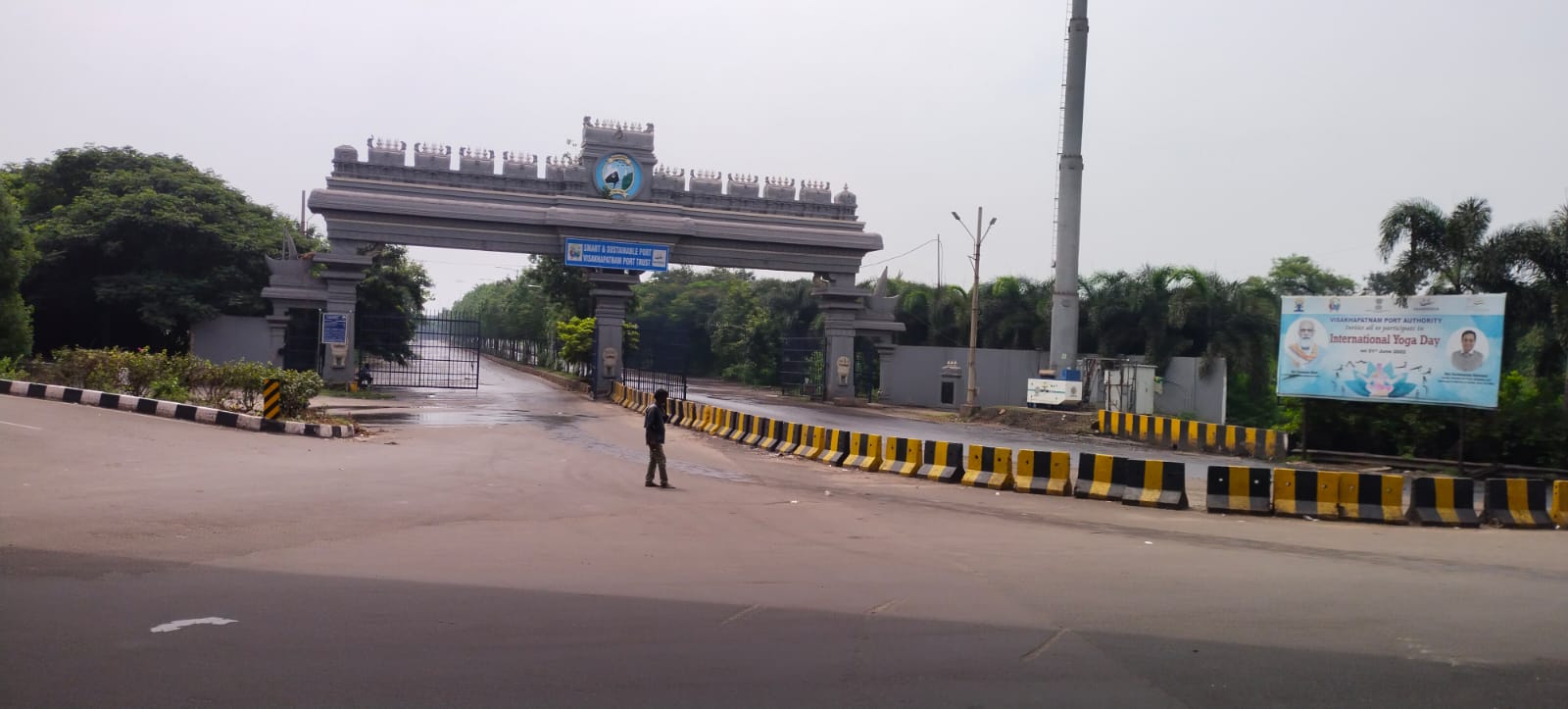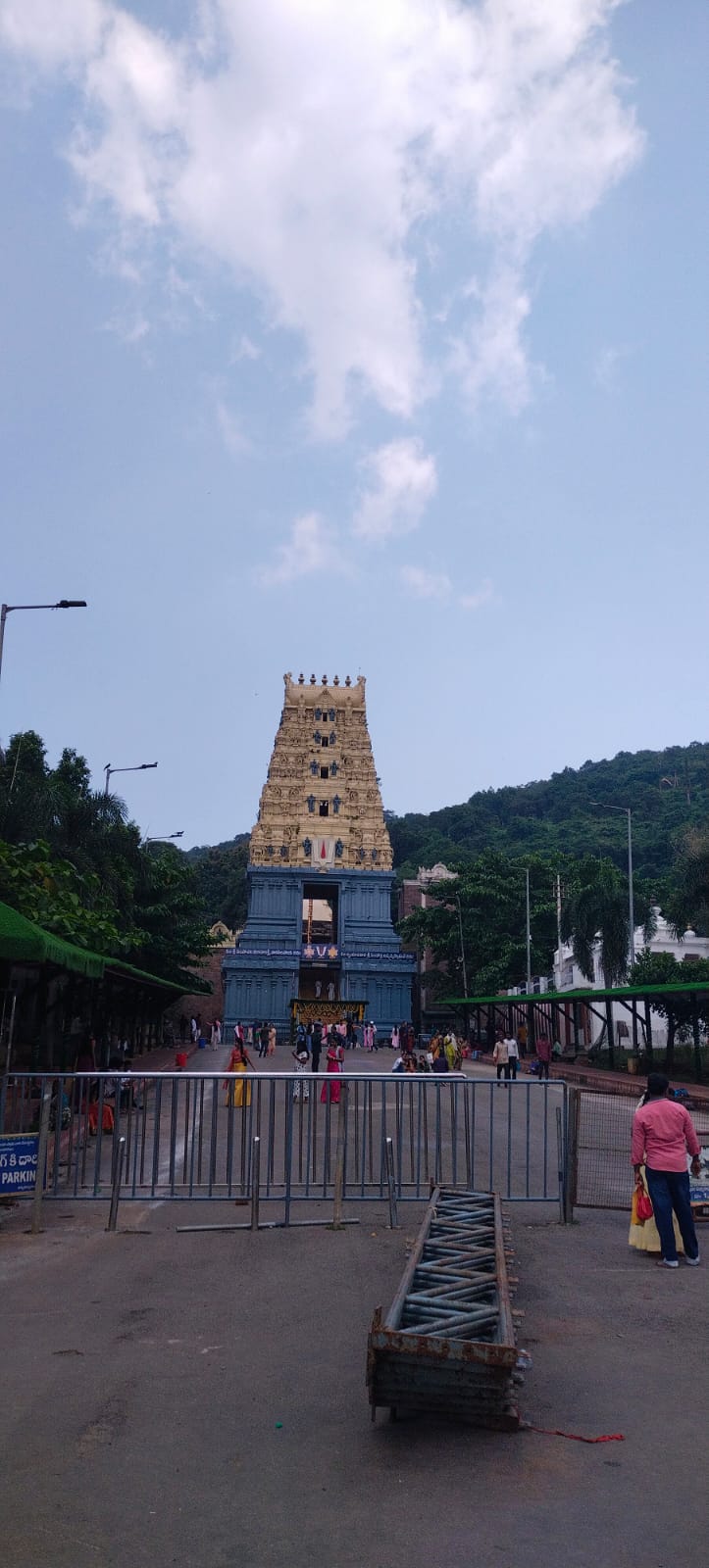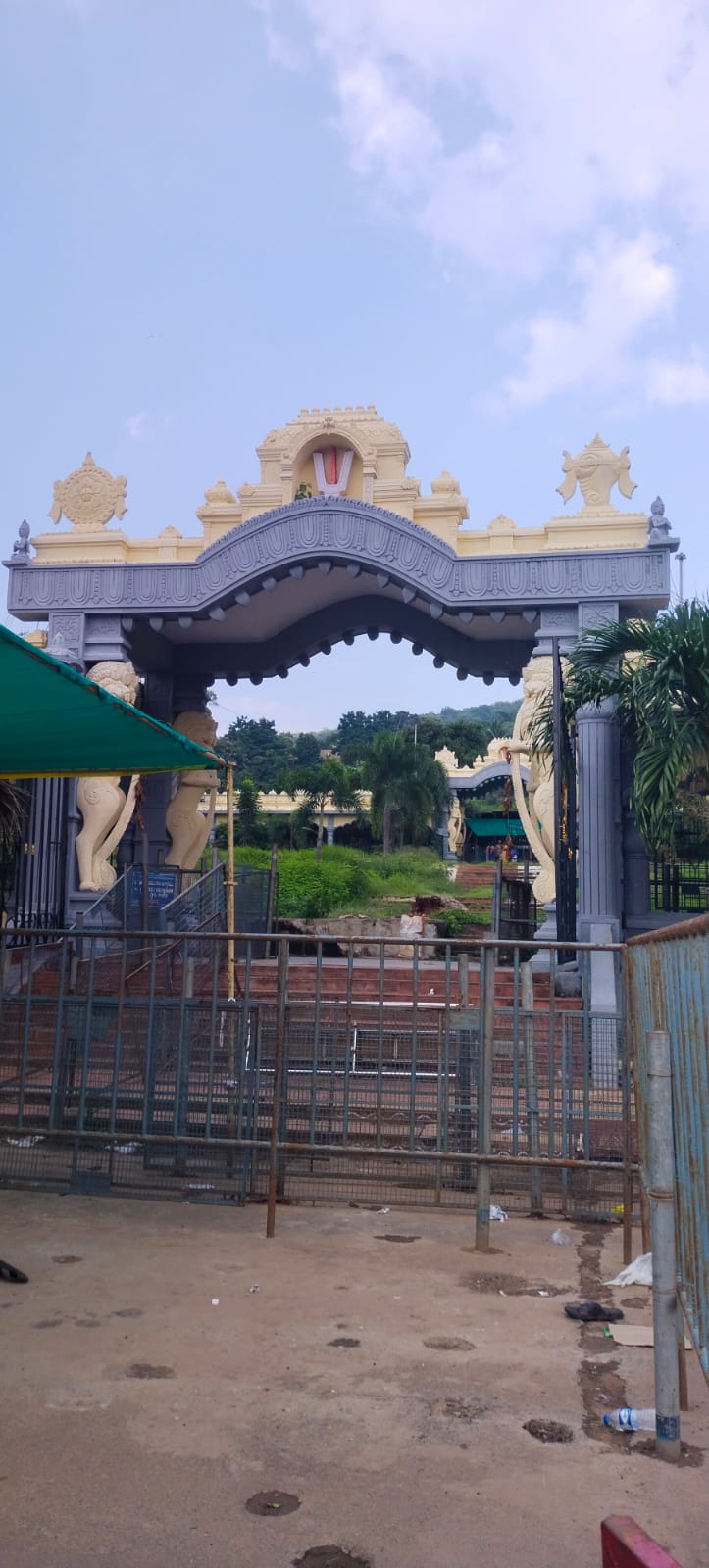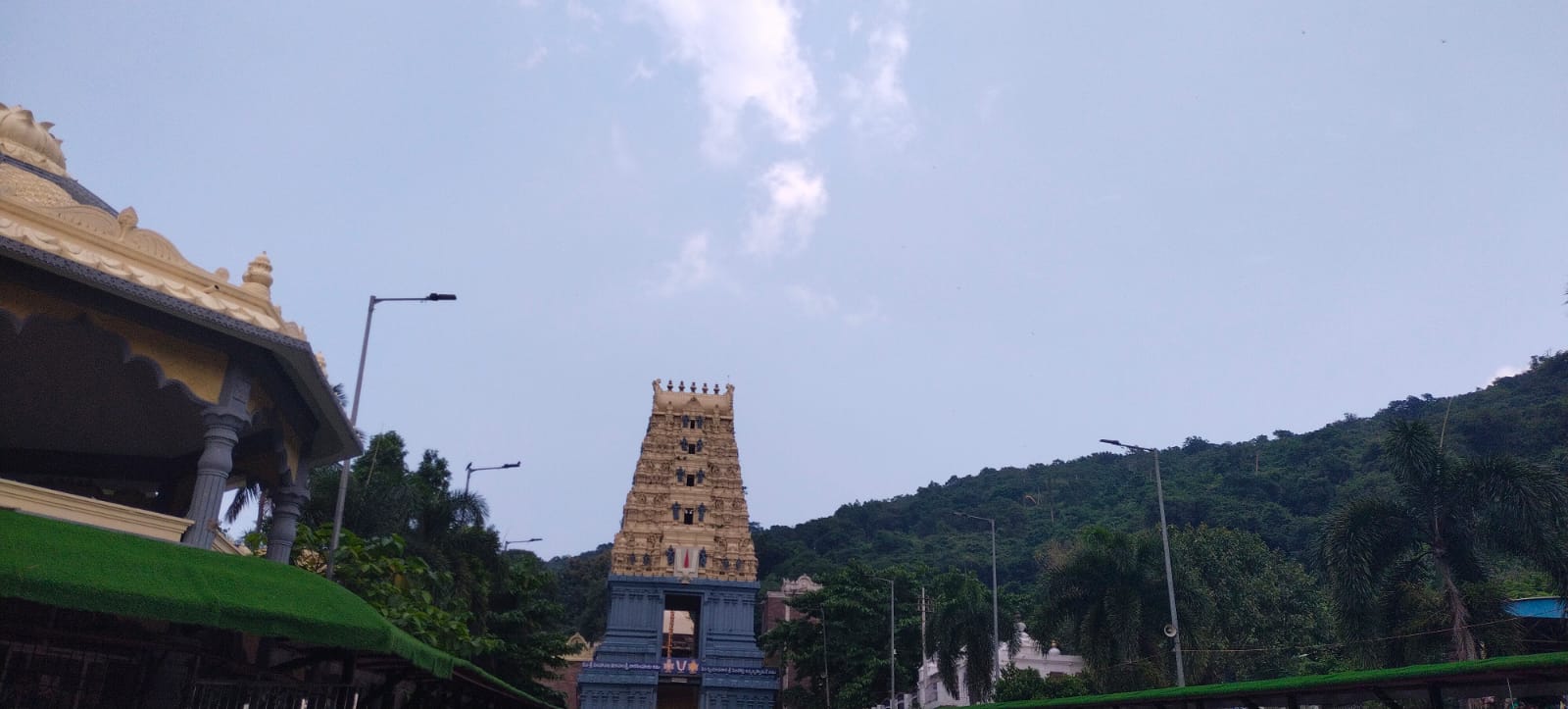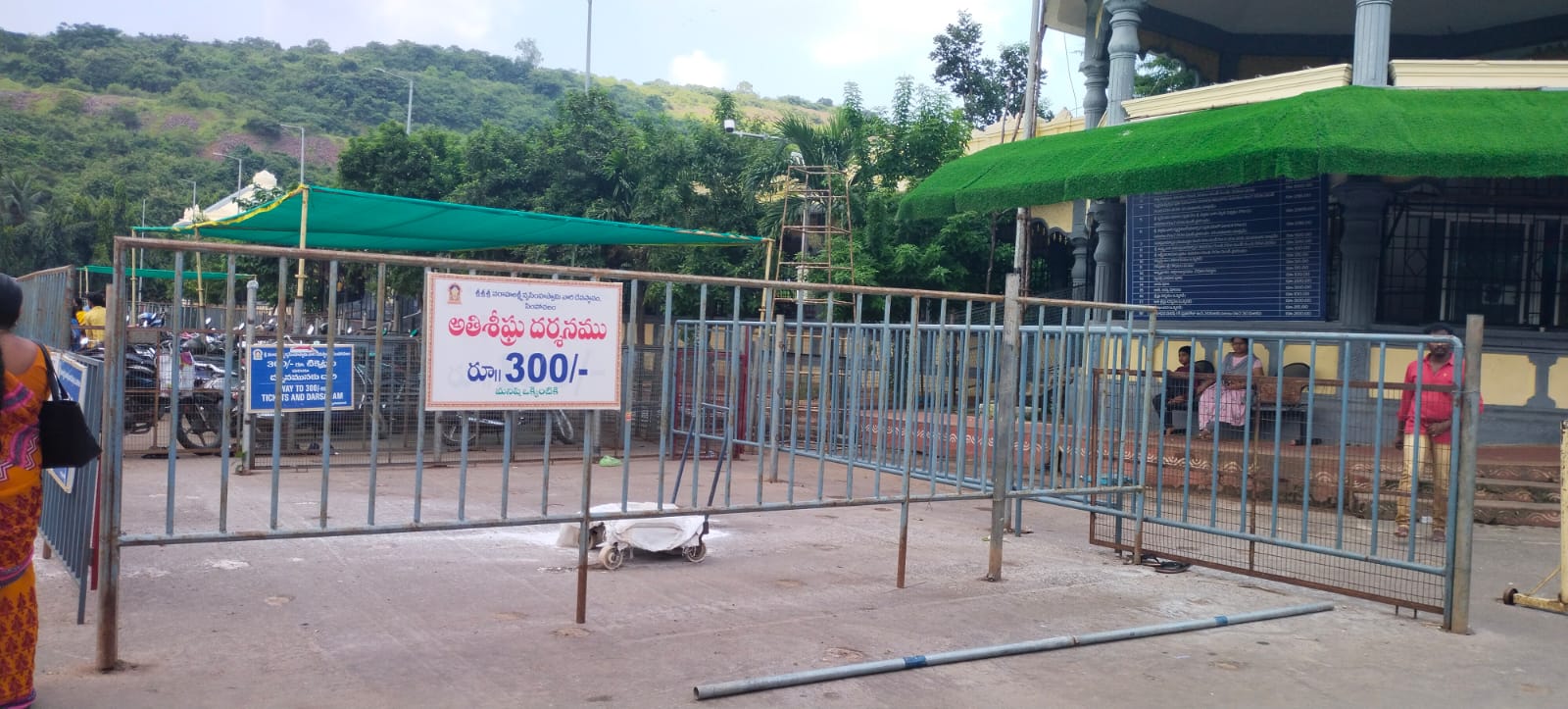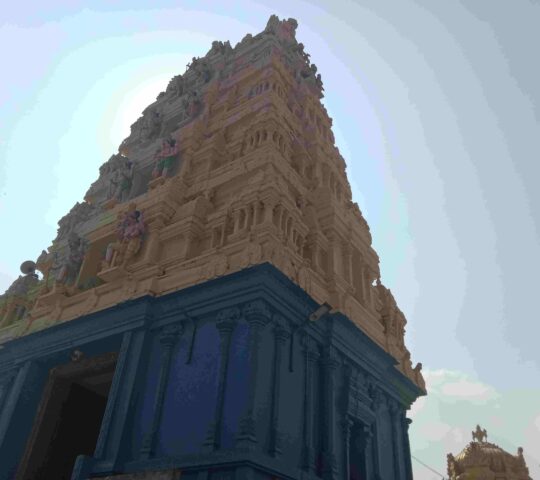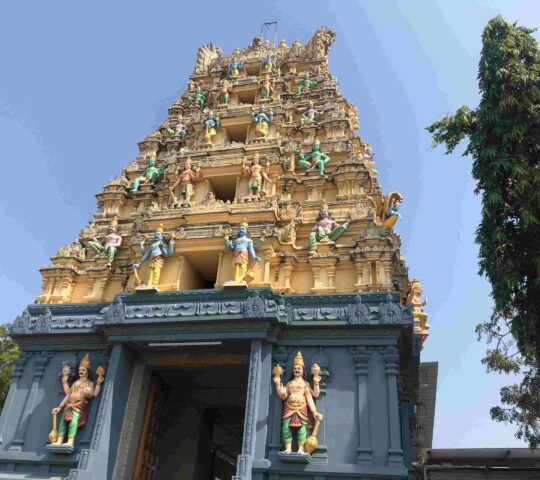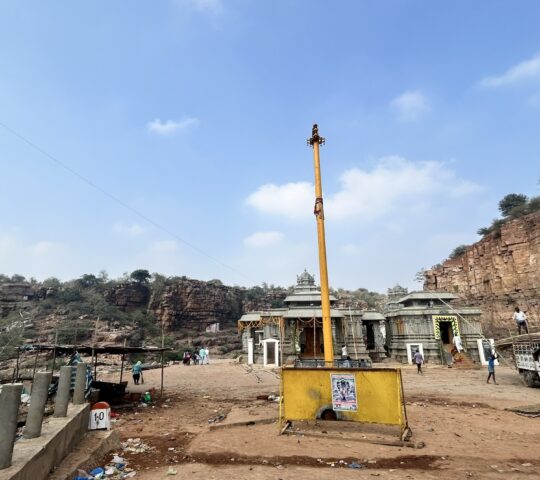Sri Varaha Lakshmi Narasimha Swamy Devasthanam , Simhachalam, Visakhapatnam, Andhra Pradesh 530028
Sri Varaha Lakshmi Narasimha Swamy Devasthanam , Simhachalam, Visakhapatnam, Andhra Pradesh 530028
శ్రీ వరాహ లక్ష్మీ నరసింహ స్వామి దేవస్థానం , సింహాచలం, విశాఖపట్నం, ఆంధ్రప్రదేశ్ 530028
Maps
Hightlight
-
 Airport
Airport
-
 Bus Facility
Bus Facility
-
 Parking
Parking
-
 Taxi
Taxi
More Information
- Temple History Sri Varaha Lakshmi Narasimha temple, Simhachalam, is a Hindu temple situated on the Simhachalam Hill Range,which is 300 metres above the sea level in the city of Visakhapatnam, Andhra Pradesh, India. It is dedicated to Lord Vishnu, who is worshipped there as Varaha Narasimha. As per the temple's legend, Vishnu manifested in this form (lion's head and human body) after saving his devotee Prahlada from a murder attempt by the latter's father Hiranyakashipu. Except on Akshaya Trutiya, the idol of Varaha Narasimha is covered with sandalwood paste throughout the year, which makes it resemble a linga. The temple was built in Kalingan architecture styles and stands unique in the historical region of Kalinga.The Present temple was built by Eastern Ganga king Narasingha Deva I in the 13th century and consecrated by his son Bhanudeva I in 1268 CE.The temple was built by Akthayi Senapati, on the command of Narasingha Deva Simhachalam is one of the 32 Narasimha temples in Andhra Pradesh which are important pilgrimage centres. It was regarded as an important centre of Vaishnavism in the medieval period along with Srikurmam and Jagannath Temple, Puri. The earliest inscription at the temple belongs to 11th-century CE recording the gift by a private individual in the era of Chola Chalukya king Kulottunga Chola, son of Raja Raja Narendra of Rajamahendravaram. The second earliest inscription is a donation of Eastern Ganga Dynasty king Anantavarman Chodaganga Deva of Kalinga who conquered Utkala (Odisha) and ruled from Ganga to Godavari. After an offering of private individual, this is the first Royal donation to the old temple of Simhachalam in 11th-century CE.In the later half of the 13th century, the temple complex underwent radical physical changes during the reign of the Eastern Ganga king Narasingha Deva I who built a new temple. The present temple was built under the Ganga ruler's guidance. Narahari Tirtha, a Dvaita philosopher and Eastern Ganga minister converted the Simhachalam temple into an educational establishment of renown and a religious centre for Vaishnavism.It later received patronage from many royal families, of which Suryavamshi Gajapati Dynasty of Odisha and Tuluva dynasty of Vijayanagara Empire are notable. The temple underwent 40 years of religious inactivity from 1564 to 1604 CE. In 1949, the temple came under the purview of the state government and is currently administered by the Simhachalam Devasthanam Board. Simhachalam temple resembles a fortress from outside with three outer courtyards and five gateways. The temple faces west instead of east, signifying victory. There are two temple tanks: Swami Pushkarini near the temple and Gangadhara at the bottom of the hill. The temple houses a number of sub-shrines and a few mandapams. The religious practices and customs of the temple are formulated by the Vaishnavite philosopher Ramanuja. They are modelled based on the Satvata Samhita, one of the 108 texts of the Pancharatra Agama. Simhachalam is the second-largest temple, after Tirumala in Andhra Pradesh, in terms of income earned.[citation needed] Devotees believe that the deity is capable of giving progeny to women and fulfilling the wishes of devotees. Kalyanotsava and Chandanotsava are the two major festivals celebrated in the temple, followed by Narasimha Jayanti, Navaratrotsava and Kamadahana. The festivals celebrated in Simhachalam have an influence of the Dravida Sampradaya. Apart from those by well-known poets, the temple is found in many literary references and lyrical works (dedicated by anonymous writers), which are preserved in the Government Oriental Manuscripts Library, Chennai. Once, the Four Kumaras, who were the mind-born sons of Lord Brahma, visited lord Vishnu's abode Vaikuntha as children. Jaya-Vijaya, the demigod gatekeepers of Vaikuntha, failed to recognise them and denied their entry. In resentment, they cursed the duo stating that they would have to give up divinity, born and live the lives of mortal beings on earth.Vishnu failed to revoke the curse of the Kumaras and felt sorry. He later offered two solutions: either being Vishnu's devotees in seven human lives or his enemies in three demonic lives. Jaya-Vijaya could not bear separation with Vishnu for a long time and chose the second possibility. In their first demonic lives during the Satya Yuga, Jaya-Vijaya were born as Hiranyakashipu and Hiranyaksha to sage Kashyapa and Diti(a daughter of Daksha) in an inauspicious time during a sunset.It is said that asuras were born to them as a result of their union at the time of dusk, which was said to be an inauspicious time for such a deed. To tease lord Brahma and other gods, Hiranyaksha ensured that earth loses its vitality and sinks into the rasatala, the lowest level in the cosmic universe. Vishnu assumed the form of a boar referred to as Varaha and restored earth to its normal position. Varaha later killed Hiranyaksha in a war that lasted for thousand years. Hiranyakashipu vowed to seek revenge and prayed to Brahma. He gained a boon which made him invulnerable to death either by day or night, either in the morning or the night, and either by a human or a beast. When the gods headed by Brahma visited Vaikuntham to tell an account of the happenings to Vishnu, a guardian named Sumukha obstructed them.They manage to meet Vishnu and also convey the misbehaviour of Sumukha. Vishnu assured that Hiranyakashipu shall be killed and Sumukha would be the serving cause. Sumukha pleaded for a pardon but Vishnu denied, saying that an offence against his devotees is inexcusable. As per Vishnu's orders, Sumukha was born as Hiranyakashipu's son Prahlada. Prahlada displayed staunch devotion towards Vishnu in his childhood. As a result, he had to face many death trails. In one such instance, Hiranyakashipu's soldiers threw him from the top of a hill and placed the mountain on him. Vishnu jumped over the hill and lifted Prahlada from the sea.Prahlada asked Vishnu to assume a deity form where the avatars of Varaha, who killed Hiranyaksha and Narasimha, the one who would kill Hiranyakashipu soon, can be seen together. Vishnu assumed the form of Varaha Narasimha, for whom Prahlada built a temple after Hiranyakashipu's death. Worship was conducted and the place was named Simhachalam (lion's hill).This is covered from 5th to 29th chapters of the legend.. శ్రీ వరాహ లక్ష్మీ నరసింహ ఆలయం, సింహాచలం, భారతదేశంలోని ఆంధ్రప్రదేశ్లోని విశాఖపట్నం నగరంలో సముద్ర మట్టానికి 300 మీటర్ల ఎత్తులో ఉన్న సింహాచలం కొండ శ్రేణిలో ఉన్న హిందూ దేవాలయం. ఇది వరాహ నరసింహునిగా పూజించబడుతున్న విష్ణువుకు అంకితం చేయబడింది. ఆలయ పురాణం ప్రకారం, విష్ణువు తన భక్తుడైన ప్రహ్లాదుడిని అతని తండ్రి హిరణ్యకశిపు హత్యాప్రయత్నం నుండి రక్షించిన తర్వాత ఈ రూపంలో (సింహం తల మరియు మానవ శరీరం) ప్రత్యక్షమయ్యాడు. అక్షయ తృతీయ నాడు తప్ప, వరాహ నరసింహ విగ్రహం ఏడాది పొడవునా గంధపు చెక్కతో కప్పబడి ఉంటుంది, ఇది లింగాన్ని పోలి ఉంటుంది. ఈ ఆలయం కళింగ నిర్మాణ శైలిలో నిర్మించబడింది మరియు కళింగ చారిత్రక ప్రాంతంలో ప్రత్యేకంగా నిలుస్తుంది. ప్రస్తుత ఆలయాన్ని 13వ శతాబ్దంలో తూర్పు గంగా రాజు I నరసింగ దేవా నిర్మించారు మరియు 1268 CEలో అతని కుమారుడు భానుదేవ I చేత ప్రతిష్ఠించబడింది. అక్తయి సేనాపతి, నరసింగ దేవా ఆజ్ఞపై సింహాచలం ఆంధ్రప్రదేశ్లోని 32 నరసింహ ఆలయాలలో ముఖ్యమైన పుణ్యక్షేత్రాలు. పూరీలోని శ్రీకూర్మం మరియు జగన్నాథ దేవాలయంతో పాటు మధ్యయుగ కాలంలో ఇది వైష్ణవుల ముఖ్యమైన కేంద్రంగా పరిగణించబడింది. ఆలయం వద్ద ఉన్న తొలి శాసనం 11వ శతాబ్దానికి చెందినది, ఇది చోళ చాళుక్య రాజు కులోత్తుంగ చోళుడు, రాజమహేంద్రవరానికి చెందిన రాజా రాజ నరేంద్ర కుమారుడు ఒక ప్రైవేట్ వ్యక్తి ఇచ్చిన బహుమతిని రికార్డ్ చేసింది. రెండవ తొలి శాసనం ఉత్కళ (ఒడిషా)ని జయించి గంగ నుండి గోదావరి వరకు పాలించిన కళింగకు చెందిన తూర్పు గంగా రాజవంశ రాజు అనంతవర్మన్ చోడగంగ దేవుడి విరాళం. ప్రైవేట్ వ్యక్తి సమర్పించిన తర్వాత, ఇది 11వ శతాబ్దం CEలో సింహాచలం పాత ఆలయానికి మొదటి రాజ విరాళం. 13వ శతాబ్దం చివరి భాగంలో, తూర్పు గంగా రాజు నరసింగ పాలనలో ఆలయ సముదాయం తీవ్రమైన భౌతిక మార్పులకు గురైంది. కొత్త గుడి కట్టిన దేవా నేను. ప్రస్తుత ఆలయం గంగా పాలకుల మార్గదర్శకత్వంలో నిర్మించబడింది. నరహరి తీర్థ, ద్వైత తత్వవేత్త మరియు తూర్పు గంగా మంత్రి, సింహాచలం ఆలయాన్ని ప్రఖ్యాత విద్యా స్థాపనగా మరియు వైష్ణవుల మత కేంద్రంగా మార్చారు. ఇది తరువాత అనేక రాజ కుటుంబాల నుండి ప్రోత్సాహాన్ని పొందింది, వీటిలో ఒడిశాలోని సూర్యవంశీ గజపతి రాజవంశం మరియు విజయనగర సామ్రాజ్యంలోని తుళువ రాజవంశం ఉన్నాయి. గుర్తించదగినది. ఈ ఆలయం 1564 నుండి 1604 CE వరకు 40 సంవత్సరాల మతపరమైన నిష్క్రియాత్మకతకు గురైంది. 1949లో, ఈ ఆలయం రాష్ట్ర ప్రభుత్వ పరిధిలోకి వచ్చింది మరియు ప్రస్తుతం సింహాచలం దేవస్థానం బోర్డుచే నిర్వహించబడుతోంది. సింహాచలం ఆలయం మూడు బయటి ప్రాంగణాలు మరియు ఐదు గేట్వేలతో బయటి నుండి కోటను పోలి ఉంటుంది. ఈ ఆలయం తూర్పుకు బదులుగా పశ్చిమం వైపు ఉంది, ఇది విజయాన్ని సూచిస్తుంది. రెండు ఆలయ ట్యాంకులు ఉన్నాయి: ఆలయానికి సమీపంలో స్వామి పుష్కరిణి మరియు కొండ దిగువన గంగాధర. ఈ ఆలయంలో అనేక ఉప ఆలయాలు మరియు కొన్ని మండపాలు ఉన్నాయి. ఆలయం యొక్క మతపరమైన పద్ధతులు మరియు ఆచారాలు వైష్ణవ తత్వవేత్త రామానుజులచే రూపొందించబడ్డాయి. అవి పాంచరాత్ర ఆగమానికి చెందిన 108 గ్రంథాలలో ఒకటైన సత్వత సంహిత ఆధారంగా రూపొందించబడ్డాయి. ఆదాయం పరంగా ఆంధ్ర ప్రదేశ్లోని తిరుమల తర్వాత సింహాచలం రెండవ అతిపెద్ద దేవాలయం. కల్యాణోత్సవం మరియు చందనోత్సవం ఈ ఆలయంలో జరిగే రెండు ప్రధాన ఉత్సవాలు, ఆ తర్వాత నరసింహ జయంతి, నవరాత్రోత్సవాలు మరియు కామదహనాలు జరుగుతాయి. సింహాచలంలో జరుపుకునే పండుగలు ద్రవిడ సంప్రదాయం యొక్క ప్రభావాన్ని కలిగి ఉంటాయి. సుప్రసిద్ధ కవులచే కాకుండా, ఈ ఆలయం చెన్నైలోని ప్రభుత్వ ఓరియంటల్ మాన్యుస్క్రిప్ట్స్ లైబ్రరీలో భద్రపరచబడిన అనేక సాహిత్య సూచనలు మరియు సాహిత్య రచనలలో (అజ్ఞాత రచయితలచే అంకితం చేయబడింది) కనుగొనబడింది. ఒకసారి, బ్రహ్మదేవునికి బుద్ధిపూర్వకంగా జన్మించిన నలుగురు కుమారులు, చిన్నతనంలో శ్రీమహావిష్ణువు వైకుంఠాన్ని సందర్శించారు. వైకుంఠ ద్వారపాలకులైన జయ-విజయ, వారిని గుర్తించడంలో విఫలమయ్యారు మరియు వారి ప్రవేశాన్ని నిరాకరించారు. ఆగ్రహంతో, వారు దైవత్వాన్ని విడిచిపెట్టి, భూమిపై మర్త్య జీవులుగా జన్మించవలసి ఉంటుందని, ద్వయాన్ని శపించారు. విష్ణువు కుమారుల శాపాన్ని ఉపసంహరించుకోవడంలో విఫలమయ్యాడు మరియు విచారం వ్యక్తం చేశాడు. అతను తరువాత రెండు పరిష్కారాలను అందించాడు: ఏడు మానవ జీవితాలలో విష్ణువు యొక్క భక్తులు లేదా మూడు రాక్షస జీవితాలలో అతని శత్రువులు. విష్ణుతో విడిపోవడాన్ని జయ-విజయ చాలా కాలం భరించలేక రెండో అవకాశాన్ని ఎంచుకున్నారు. సత్య యుగంలో వారి మొదటి రాక్షస జీవితంలో, సూర్యాస్తమయం సమయంలో ఒక అశుభ సమయంలో కశ్యప మరియు దితి (దక్షుని కుమార్తె) ఋషికి జయ-విజయలు హిరణ్యకశిపుడు మరియు హిరణ్యాక్షలుగా జన్మించారు. ఫలితంగా వారికి అసురులు జన్మించారని చెబుతారు. సంధ్యా సమయంలో వారి కలయిక, అటువంటి కార్యానికి అశుభ సమయం అని చెప్పబడింది. లార్డ్ బ్రహ్మ మరియు ఇతర దేవతలను ఆటపట్టించడానికి, హిరణ్యాక్షుడు భూమి తన శక్తిని కోల్పోయేలా చూసాడు మరియు విశ్వ విశ్వంలో అత్యల్ప స్థాయి అయిన రసాతలంలో మునిగిపోయాడు. విష్ణువు వరాహా అని పిలవబడే పంది రూపాన్ని ధరించాడు మరియు భూమిని దాని సాధారణ స్థితికి పునరుద్ధరించాడు. వరాహ తరువాత వెయ్యి సంవత్సరాల పాటు జరిగిన యుద్ధంలో హిరణ్యాక్షుడిని చంపాడు. హిరణ్యకశిపుడు
-
Sub Temples
🛕Lord Nara Simha Swamy
🛕నరసింహ స్వామి -
Things to Cover
🙏🏼Take darshan and blessings of Lord Nara Simha swamy
🙏🏼నరసింహస్వామి దర్శనం మరియు ఆశీస్సులు పొందండి - Dress Code 🥻Traditional Dress🥻సాంప్రదాయ దుస్తులు
-
Pooja Details
🌹Swarna Pushparchana (6:30 am – 8:00 am Thursday ) - Rs.1000 for a couple or Single
🌹Nitya Kalyanam (9:30 am – 11:0 am Daily) Rs.1000 for a couple or Single
🌹Astottaram (During Temple Timings Daily) Rs.200
🌹Special Darshan Ticket During Temple Timings Daily Rs.100
🌹Ati seegra Darshanam - 300/-
🌹స్వర్ణ పుష్పార్చన (ఉదయం 6:30 - 8:00 గురువారం ) - జంట లేదా ఒంటరి వారికి రూ.1000
🌹నిత్య కళ్యాణం (ప్రతిరోజు ఉదయం 9:30 - 11:0 వరకు) జంట లేదా ఒంటరి వారికి రూ.1000
🌹అష్టోత్తరం (ఆలయ సమయాలలో రోజువారీ) రూ.200
🌹ఆలయ సమయాలలో ప్రత్యేక దర్శనం టిక్కెట్టు రోజువారీ రూ.100
🌹అతి శీఘ్ర దర్శనం - 300/- -
Festivals / Jaatra
🌹Kalyanotsava
🌹Chandanotsava
🌹Narasimha Jayanti
🌹Navaratrotsava
🌹Kamadahana
🌹Krishna Janmashtami
🌹Karthika Deepavali
🌹Giripradakshina
🌹కల్యాణోత్సవం
🌹చందనోత్సవం
🌹నరసింహ జయంతి
🌹నవరాత్రోత్సవాలు
🌹కామదహన
🌹కృష్ణ జన్మాష్టమి
🌹కార్తీక దీపావళి
🌹గిరిప్రదక్షిణ -
Travel Guide
🚉Temple 19 Km from Visakhapatanam, which is well connected by road, air and Train. From Visakhapatnam Railway station, the temple is 16 km away
🚉 ఆలయం విశాఖపట్నం నుండి 19 కి.మీ దూరంలో ఉంది, ఇది రోడ్డు, విమాన మరియు రైలు మార్గాల ద్వారా బాగా అనుసంధానించబడి ఉంది. విశాఖపట్నం రైల్వే స్టేషన్ నుండి, ఆలయం 16 కి.మీ దూరంలో ఉంది.
FAQ's
Do we have parking?
Yes , there is sufficient parking available at this temple
